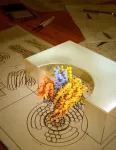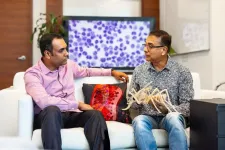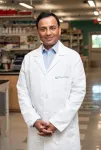(Press-News.org) CAMBRIDGE, MA -- When babies first begin to talk, their vocabulary is very limited. Often one of the first sounds they generate is “da,” which may refer to dad, a dog, a dot, or nothing at all.
How does an adult listener make sense of this limited verbal repertoire? A new study from MIT and Harvard University researchers has found that adults’ understanding of conversational context and knowledge of mispronunciations that children commonly make are critical to the ability to understand children’s early linguistic efforts.
Using thousands of hours of transcribed audio recordings of children and adults interacting, the research team created computational models that let them start to reverse engineer how adults interpret what small children are saying. Models based on only the actual sounds children produced in their speech did a relatively poor job predicting what adults thought children said. The most successful models made their predictions based on large swaths of preceding conversations that provided context for what the children were saying. The models also performed better when they were retrained on large datasets of adults and children interacting.
The findings suggest that adults are highly skilled at making these context-based interpretations, which may provide crucial feedback that helps babies acquire language, the researchers say.
“An adult with lots of listening experience is bringing to bear extremely sophisticated mechanisms of language understanding, and that is clearly what underlies the ability to understand what young children say,” says Roger Levy, a professor of brain and cognitive sciences at MIT. “At this point, we don’t have direct evidence that those mechanisms are directly facilitating the bootstrapping of language acquisition in young children, but I think it’s plausible to hypothesize that they are making the bootstrapping more effective and smoothing the path to successful language acquisition by children.”
Levy and Elika Bergelson, an associate professor of psychology at Harvard, are the senior authors of the study, which appears today in Nature Human Behavior. MIT postdoc Stephan Meylan is the lead author of the paper.
Adult listening skills are critical
While many studies have investigated how children learn to speak, in this project, the researchers wanted to flip the question and study how adults interpret what children say.
“While people have looked historically at a number of features of the learner, and what is it about the child that allows them to learn things from the world, very little has been done to look at how they are understood and how that might influence the process of language acquisition,” Meylan says.
Previous research has shown that when adults speak to each other, they use their beliefs about how other people are likely to talk, and what they’re likely to talk about, to help them understand what their conversational partner is saying. This strategy, known as “noisy channel listening,” makes it easier for adults to handle the complex task of deciphering the acoustic sounds they’re hearing, especially in environments where voices are muffled or there is a lot of background noise, or when speakers have different accents.
In this study, the researchers explored whether adults can also apply this technique to parsing the often seemingly nonsensical utterances produced by children who are learning to talk.
“This problem of interpreting what we hear is even harder for child language than ordinary adult language understanding, which is actually not that easy either, even though we’re very good at it,” Levy says.
For this study, the researchers made use of datasets originally generated at Brown University in the early 2000s, which contain hundreds of hours of transcribed conversations between children ages 1 to 3 and their caregivers. The data include both phonetic transcriptions of the sounds produced by the children and the text of what the transcriber believed the child was trying to say.
The researchers used other datasets of child language (which included about 18 million spoken words) to train computational language models to predict what words the children were saying in the original dataset, based on the phonetic transcription. Using neural networks, they created many different models, which varied in the sophistication of their knowledge of conversational topics, grammar, and children’s mispronunciations. They also manipulated how much of the conversational context each model was allowed to analyze before making its predictions of what the children said. Some models took into account just one or two words spoken before the target word, while others were allowed to analyze up to 20 previous utterances in the exchange.
The researchers found that using the acoustics of what the child said alone did not lead to models that were particularly accurate at predicting what adults thought children said. The models that did best used very rich representations of conversational topics, grammar, and beliefs about what words children are likely to say (ball, dog or baby, rather than mortgage, for example). And much like humans, the models’ predictions improved as they were allowed to consider larger chunks of previous exchanges for context.
A feedback system
The findings suggest that when listening to children, adults base their interpretation of what a child is saying on previous exchanges that they have had. For example, if a dog had been mentioned earlier in the conversation, “da” was more likely to be interpreted by an adult listener as “dog.”
This is an example of a strategy that humans often use in listening to other adults, which is to base their interpretation on “priors,” or expectations based on prior experience. The findings also suggest that when listening to children, adult listeners incorporate expectations of how children commonly mispronounce words, such as “weed” for “read.”
The researchers now plan to explore how adults’ listening skills, and their subsequent responses to children, may help to facilitate children’s ability to learn language.
“Most people prefer to talk to others, and I think babies are no exception to this, especially if there are things that they might want, either in a tangible way, like milk or to be picked up, but also in an intangible way in terms of just the spotlight of social attention,” Bergelson says. “It’s a feedback system that might push the kid, with their burgeoning social skills and cognitive skills and everything else, to continue down this path of trying to interact and communicate.”
One way the researchers hope to study this interplay between child and adult is by combining computational models of how children learn language with the new model of how adults respond to what children say.
“We now have this model of an adult listener that we can plug into models of child learners, and then those learners can leverage the feedback provided by the adult model,” Meylan says. “The next frontier is trying to understand how kids are taking the feedback that they get from these adults and build a model of what these children expect that an adult would understand.”
###
The research was funded by the National Science Foundation, the National Institutes of Health, and a CONVO grant to MIT’s Department of Brain and Cognitive Sciences from the Simons Center for the Social Brain.
END
How adults understand what kids are saying
It’s not easy to parse young children’s words, but adults’ beliefs about what children want to communicate helps make it possible, a new study finds
2023-10-26
ELSE PRESS RELEASES FROM THIS DATE:
DNA Origami nanoturbine sets new horizon for nanomotors
2023-10-26
Nanoturbines: the heart of advancements
Flow-driven turbines lie at the heart of many revolutionary machines that have shaped our societies, from windmills to airplanes. Even life itself depends critically on turbines for fundamental processes, such as the FoF1-ATP synthase that produces fuels for biological cells and the bacterial flagella motor that propels bacteria. “Our nanoturbine has a 25-nanometer diameter rotor made from DNA material with blades configured in a right-handed or left-handed sense to control the direction of rotation. To operate, this structure is ...
NSF awards up to $21.4M for design of next-gen telescopes to capture earliest moments of universe
2023-10-26
The National Science Foundation has awarded $3.7 million to the University of Chicago for the first year of a grant that may provide up to $21.4 million for the final designs for a next-generation set of telescopes to map the light from the earliest moments of the universe—the Cosmic Microwave Background.
Led by the University of Chicago and Lawrence Berkeley National Laboratory, the collaboration seeks to build telescopes and infrastructure in both Antarctica and Chile to search for what are known as “primordial” gravitational waves—the vibrations from the Big Bang itself. It would also map the microwave light ...
Malaria protein discovery offers path for novel antimalarial intervention strategies
2023-10-26
The discovery of a malaria protein that helps the parasite grow inside red blood cells and plays a key regulatory role in the parasite’s immune evasion tactics could pave the way for new vaccines or therapeutics to combat the deadly infection.
The protein, known as PfAP2-P, was previously identified in a KAUST-led study that explored malarial genes and proteins displaying rhythmic 24-hour expression patterns — an adaptation that allows the parasite to synchronize its activities with those of the host during the human blood stage of its developmental cycle[1].
The expression levels of PfAP2-P seem to peak first around ...
Psoriasis not caused by spontaneous mutations in skin cells
2023-10-26
Psoriasis — a chronic skin condition — is not caused or spread by spontaneous genetic mutations in the skin, new research suggests.
The team, from the Wellcome Sanger Institute and collaborators, sequenced skin samples from 111 people with psoriasis. They didn’t find any mutated genes in the psoriatic patches that weren’t also mutated in the individual’s unaffected skin tissue.
The study, published today (26 October) in Nature Genetics, suggests that unlike other inflammatory diseases, such as inflammatory bowel disease or chronic liver disease, somatic mutations were not responsible for the start or spread of psoriasis.
Confirming that psoriasis ...
Marine protected areas and climate change
2023-10-26
An international team has developed the first comprehensive framework for designing networks of marine protected areas that can help vulnerable species survive as climate change drives habitat loss.
In a paper published Oct. 26 in One Earth, the researchers outlined guidelines for governments to provide long-distance larval drifters, like urchins and lobsters, as well as migratory species, like turtles and sharks, with protected stopovers along coastal corridors. Led by Stanford marine conservation scientist Nur Arafeh-Dalmau, the team included 50 scientists and practitioners ...
Genetics links endometriosis and IBS
2023-10-26
University of Queensland researchers have shown that endometriosis and irritable bowel syndrome (IBS) share genetic risk factors, explaining why patients with one condition may also have the other.
Professor Grant Montgomery and Dr Sally Mortlock at UQ’s Institute for Molecular Bioscience found a significant relationship between the risks for endometriosis and common gastrointestinal disorders such as IBS, peptic ulcer disease (PUD) and gastro-oesophageal reflux disease (GORD).
“This genetic finding supports the clinical observation of an increased incidence of gastrointestinal disorders in women with endometriosis,” ...
Regenstrief, VA researchers co-edit journal special supplement addressing far-reaching impact of EHR transitions
2023-10-26
INDIANAPOLIS -- Two Regenstrief Institute and U.S. Department of Veterans Affairs researchers are key leaders of a national journal’s special supplement designed to help address the plethora of issues that can accompany a healthcare system’s transition to a new electronic health record (EHR) system.
Regenstrief Institute’s David Haggstrom, M.D., MAS, and Michael Weiner, M.D., MPH, are among four guest editors who have spent the last two years leading content development for a Journal of General Internal Medicine (JGIM) special supplement ...
City of Hope, TGen awarded five-year, $4.5 million grant to advance liquid biopsy for pancreatic cancer
2023-10-26
LOS ANGELES and PHOENIX — City of Hope®, one of the largest cancer research and treatment organizations in the United States, and TGen are leading an international group that has been awarded $4.5 million to validate a liquid biopsy for the early detection of pancreatic cancer. The blood-based diagnostic developed by the National Cancer Institute’s Pancreatic Cancer Detection Consortium (PCDC) leverages exosomal microRNAs that serve as a biomarker or unique RNA fingerprint for the early detection of disease or recurrence.
Enrollment of patients with early-stage pancreatic ductal adenocarcinoma (PDAC), a ...
Mount Sinai receives $4.6 million from The Pershing Square Foundation to support women’s health research and careers for women in science
2023-10-26
(New York, NY – October 26, 2023) – The Icahn School of Medicine at Mount Sinai has received a $4.6 million gift from The Pershing Square Foundation to support women’s health research and advance careers for female scientists. Part of an original nearly $21 million gift that expanded a COVID-19 testing program for New York City schools and other organizations, this boost in women-focused initiatives connects The Pershing Square Foundation’s interest in supporting women in science to Mount Sinai’s leading researchers and key initiatives in gender-based science and health.
“We ...
Announcing the ADA Forsyth Institute: a world-class organization for oral health research and innovation
2023-10-26
SOMERVILLE, Mass., Oct. 26, 2023 – The American Dental Association (ADA) and the Forsyth Institute today announced the formation of the ADA Forsyth Institute, which brings together unparalleled talent, visionary research opportunities and dynamic innovation prospects, dedicated to advancing oral health through scientific innovation and research.
“The new ADA Forsyth Institute will continue to advance oral and overall health through ground-breaking research and innovation,” said Massachusetts Governor Maura Healey. “The Forsyth ...
LAST 30 PRESS RELEASES:
Making lighter work of calculating fluid and heat flow
Normalizing blood sugar can halve heart attack risk
Lowering blood sugar cuts heart attack risk in people with prediabetes
Study links genetic variants to risk of blinding eye disease in premature infants
Non-opioid ‘pain sponge’ therapy halts cartilage degeneration and relieves chronic pain
AI can pick up cultural values by mimicking how kids learn
China’s ecological redlines offer fast track to 30 x 30 global conservation goal
Invisible indoor threats: emerging household contaminants and their growing risks to human health
Adding antibody treatment to chemo boosts outcomes for children with rare cancer
Germline pathogenic variants among women without a history of breast cancer
Tanning beds triple melanoma risk, potentially causing broad DNA damage
Unique bond identified as key to viral infection speed
Indoor tanning makes youthful skin much older on a genetic level
Mouse model sheds new light on the causes and potential solutions to human GI problems linked to muscular dystrophy
The Journal of Nuclear Medicine ahead-of-print tip sheet: December 12, 2025
Smarter tools for peering into the microscopic world
Applications open for funding to conduct research in the Kinsey Institute archives
Global measure underestimates the severity of food insecurity
Child survivors of critical illness are missing out on timely follow up care
Risk-based vs annual breast cancer screening / the WISDOM randomized clinical trial
University of Toronto launches Electric Vehicle Innovation Ontario to accelerate advanced EV technologies and build Canada’s innovation advantage
Early relapse predicts poor outcomes in aggressive blood cancer
American College of Lifestyle Medicine applauds two CMS models aligned with lifestyle medicine practice and reimbursement
Clinical trial finds cannabis use not a barrier to quitting nicotine vaping
Supplemental nutrition assistance program policies and food insecurity
Switching immune cells to “night mode” could limit damage after a heart attack, study suggests
URI-based Global RIghts Project report spotlights continued troubling trends in worldwide inhumane treatment
Neutrophils are less aggressive at night, explaining why nighttime heart attacks cause less damage than daytime events
Menopausal hormone therapy may not pose breast cancer risk for women with BRCA mutations
Mobile health tool may improve quality of life for adolescent and young adult breast cancer survivors
[Press-News.org] How adults understand what kids are sayingIt’s not easy to parse young children’s words, but adults’ beliefs about what children want to communicate helps make it possible, a new study finds




